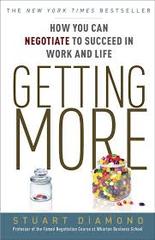 Google's internal negotiation course uses the book Getting More by Stuart Diamond, so I figured it was worth a read. It was alright but definitely not the most useful book on negotiation I've read. I much more prefer the classic Getting to Yes, which was used in Stanford's and UCLA Anderson's negotiation classes. I found Getting More to be way too heavy on anecdotes and stories. This was nice from the perspective of seeing many examples of the techniques in action, but it was overwhelming how many examples there indeed were in comparison to concrete explanation of the techniques and how to learn them. The book claimed at the beginning it would teach a highly disciplined and structured approach to preparing and creating a "List" and using techniques from a wallet card one can download, and I expected that explanation of all this would be the bulk of the book. Instead, this was glossed over in one chapter with barely any low-level explanation, and the rest of the book was devoted to applications throughout all fields of life from parenting to government. Also, I would've loved to read a lot more of the actual dialogues and transcripts of the example negotiations; instead, I read a sample phrase here and there but mostly just how a negotiation was concluded or a problem solved (instead of the full gory details of how the negotiator got there, which is what I would've preferred). All that criticism aside, I did get some very useful bits of information from the book. I liked the emphasis on and many examples of trading items of unequal value and seeing the pictures in other people's heads. These two concepts seem very powerful. Below are my full notes. I think the book was a nice complement to more structured negotiation reading and courses, but I don't think it's enough of a standalone guide to serve as a first book or introduction to the subject.
7 Comments
Inspired by the author of The Happiness Project, I decided to write down my own top personal commandments that came to mind quickly. I'm sure this list will change over time, and it'll be interesting to see how that happens.
Steve Soboroff recently spoke at my leadership and ethics class led by Mayor Riordan, and it was a fun, very personal discussion. Steve is a successful real estate developer and has worked as a land broker for many large shopping center deals. He was also pivotal to bringing Staples Center to LA.
His talk centered on an acrostic about the characteristics of leaders and effective people:
|
Archives
February 2023
Categories
All
Subscribe |


 RSS Feed
RSS Feed

